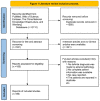The clinical characteristics and pathogenic variants of primary pigmented nodular adrenocortical disease in 210 patients: a systematic review
- PMID: 39006359
- PMCID: PMC11240189
- DOI: 10.3389/fendo.2024.1356870
The clinical characteristics and pathogenic variants of primary pigmented nodular adrenocortical disease in 210 patients: a systematic review
Abstract
Aims: Primary pigmented nodular adrenocortical disease (PPNAD), as a rare kind of Cushing's syndrome, is frequently misdiagnosed. To get a better understanding of the disease, we analyzed the clinical characteristics and pathogenic variants of PPNAD.
Methods: Databases were searched, and the pathogenic variants and clinical manifestations of patients were summarized from the relevant articles.
Results: A total of 210 patients in 86 articles were enrolled with a median age of 22 and a female-to-male ratio of 2:1. Sixty-six (31.43%) patients were combined with Carney complex (CNC) and 94.29% were combined with osteoporosis/osteopenia. Among 151 patients who underwent genetic testing, 87.42% (132/151) had pathogenic variants. Six gene mutations (PRKAR1A, PDE11A, PRKACA, CTNNB1, PDE8B, and ARMC5) were detected in the patients. The most common mutation was PKAR1A, accounting for 79.47% (120/151). There was a significant correlation between PRKAR1A pathogenic variant and spotty skin pigmentation in CNC concurrent with PPNAD (p < 0.05). Among pregnant patients with PPNAD, those without surgical treatment and with bilateral adrenalectomy suffered from a high-risk perinatal period. However, patients with unilateral adrenalectomy presented a safe perinatal period.
Conclusions: For young patients with Cushing's syndrome, especially female patients with spotty skin pigmentation and osteoporosis/osteopenia, PPNAD should be considered. Unilateral adrenal resection may be considered as an option for women with fertility needs. In view of the difficulty of PPNAD diagnosis, genetic testing before surgery might be a reasonable option. Patients with PPNAD with spotty skin pigmentation should consider the PRKAR1A pathogenic variant and pay attention to CNC.
Systematic review registration: https://www.crd.york.ac.uk/prospero, identifier CRD42023416988.
Keywords: Cushing’s syndrome; PRKAR1A; clinical characteristics; pathogenic variants; primary pigmented nodular adrenocortical disease.
Copyright © 2024 Sun, Ding, He, Fu, Li, Feng, Dong and Liao.
Conflict of interest statement
The authors declare that the research was conducted in the absence of any commercial or financial relationships that could be construed as a potential conflict of interest.
Figures
References
-
- Navarro Moreno C, Delestienne A, Marbaix E, Aydin S, Hörtnagel K, Lechner S, et al. . Familial forms of Cushing syndrome in primary pigmented nodular adrenocortical disease presenting with short stature and insidious symptoms: A clinical series. Horm Res Paediatr. (2018) 89(6):423–33. doi: 10.1159/000488761 - DOI - PubMed
Publication types
MeSH terms
Substances
LinkOut - more resources
Full Text Sources
Miscellaneous




